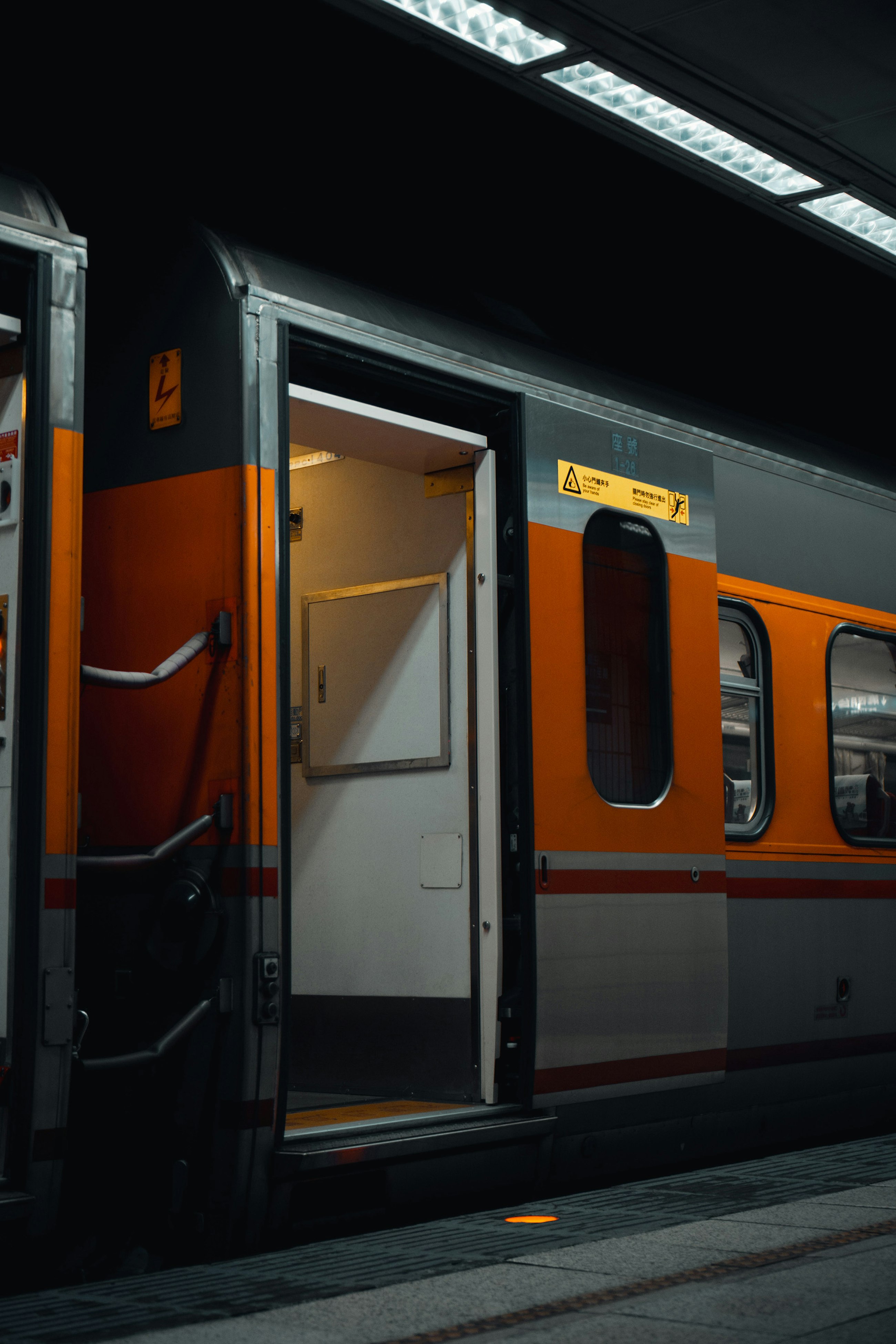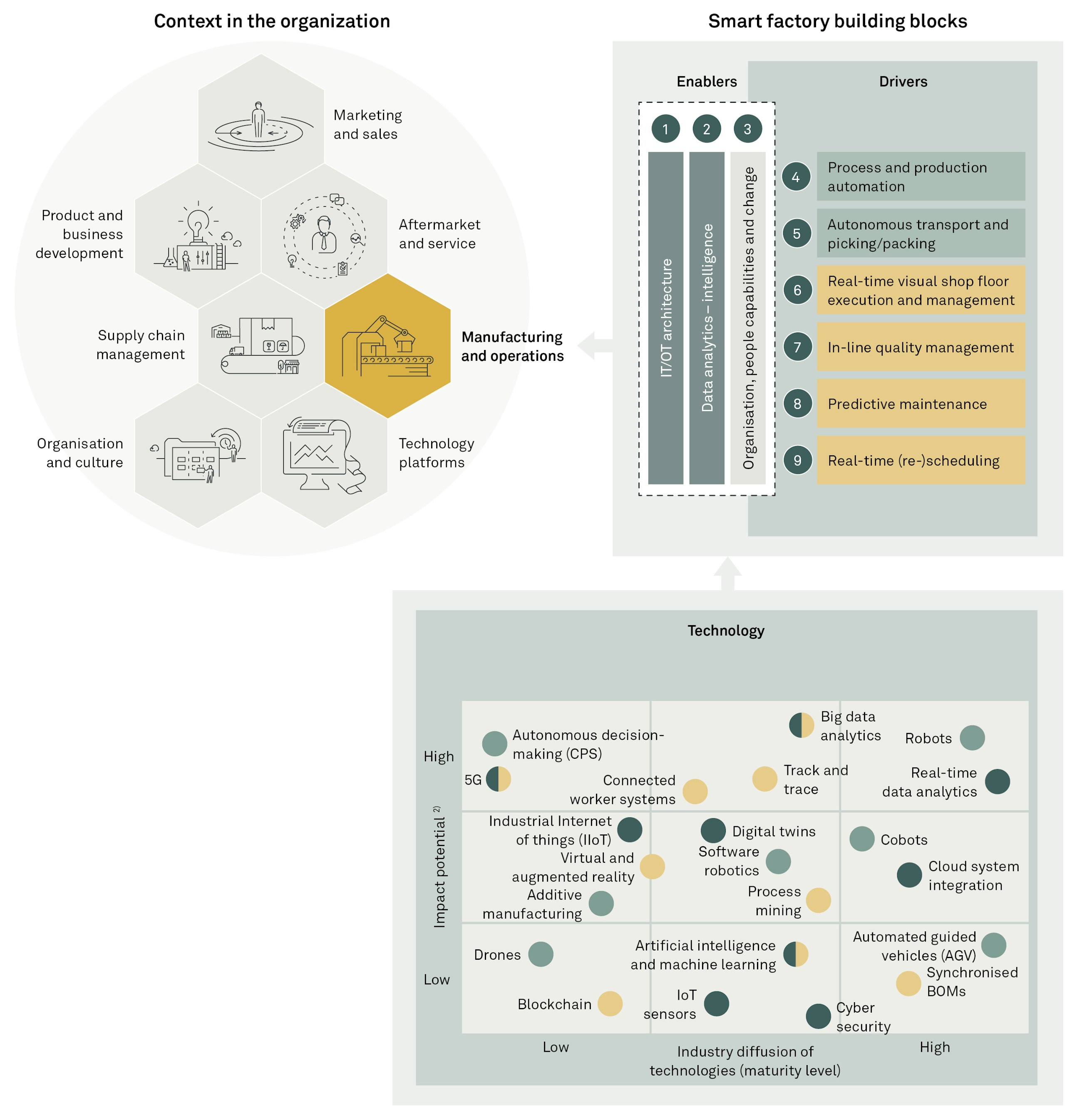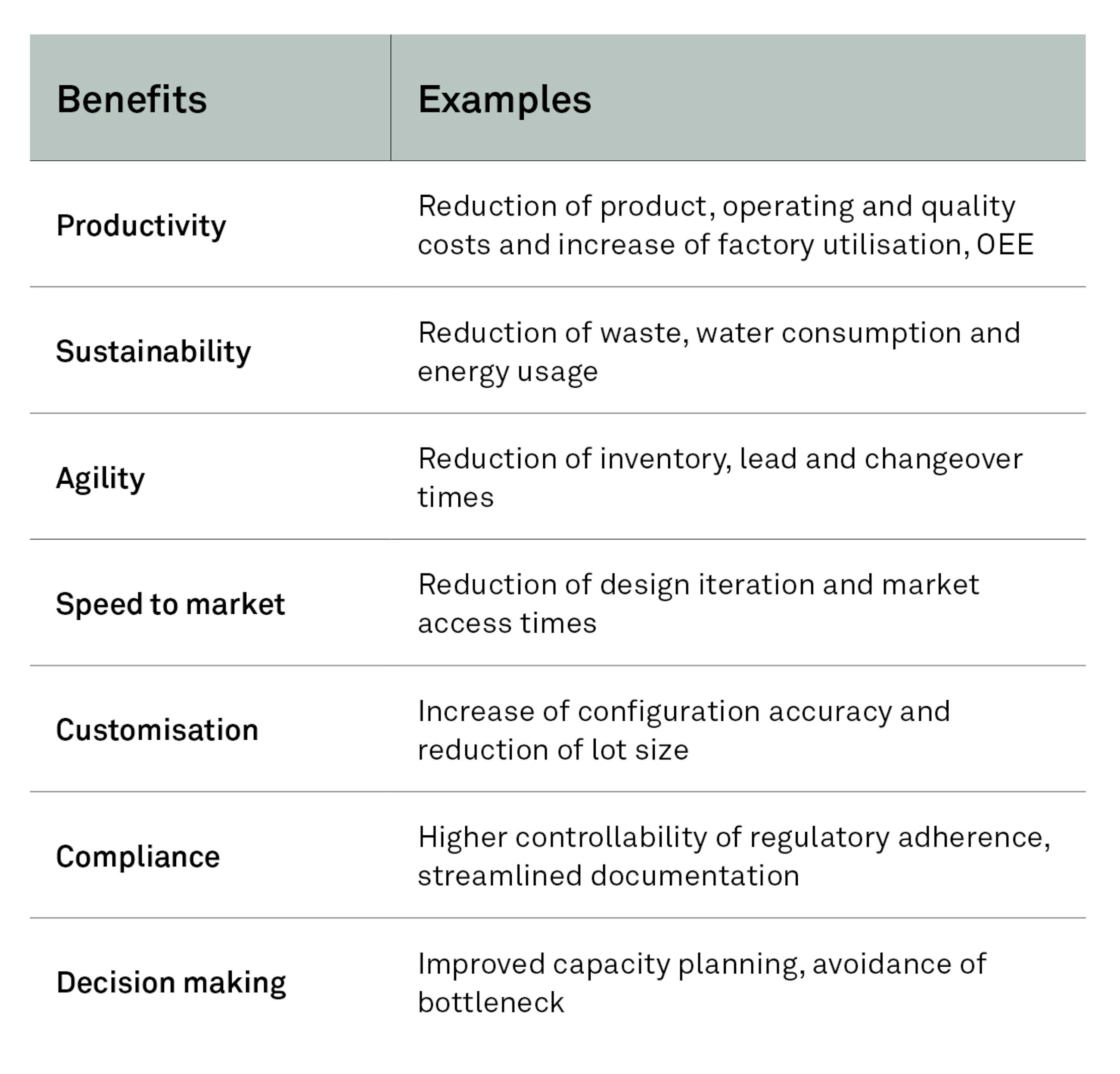What does it take to embark on the journey towards higher productivity, agility and better customer service?
15 March 2022
Companies that want to remain competitive in the long term cannot avoid transforming traditional manufacturing plants into “smart factories”. And as it turns out, embarking on this transformation journey is not as hard as it would seem. This article provides you with an overview of the major drivers and the impact case for change, the main building blocks, common barriers to start, key success factors and our view on how you implement smart factories.
Why is the transformation to smart factories happening now?
Smart factories are creating huge business and financial impact, and we experience more and more companies embarking on the journey towards implementing smart factories. But why is this happening now? There is no single reason that leads the way but rather multiple converging trends that mutually amplify each other and create a critical pivoting point for organisations.
Continued digitalisation
The foundation of smart factories is formed by the continued fast development of (new) connected technologies combined with the abundantly available data generated by an ocean of sensors. This is further amplified by an increase in computing power and improvements of artificial intelligence capabilities that help to not only capture information but also to extract insights and predict future developments to allow for proactive rather than reactive decisions.
Increased market volatility
For all organisations, and in particular those in the manufacturing industry, the volatile economic development globally – especially in combination with the now multi-year pandemic situation – creates a challenging environment. And so, organisations that want to remain competitive and maintain growth increasingly need to become agile and scalable to respond to the unpredictability of supply and demand. To survive and thrive in today’s competitive and fast-paced environment, it is vital to be able to have instant transparency on inventory, production, capacity, lead times and other factors that support rapid decision-making.
Declining availability of labour
In a market where entrepreneurial and digitally savvy labour is essential to design, build, operate and maintain the next generation of manufacturing machinery, it is no surprise that organisations are fighting for the same limited pool of people with these key capabilities. This high demand is further amplified by the demographically driven churn of highly experienced employees leaving organisations to enjoy their well-earned retirement. This is even more compounded by a new wave called “The Great Resignation” in which people re-evaluate their work-life setup and quit their job en masse to choose alternative models. Smart factories can help solve these challenges by making organisations less dependent on labour through increasing automation throughout the manufacturing cycle.
“Successful smart manufacturing is all about creating value for and embarking on a common journey with our customers. ... These solutions need to be scalable with the ability to grow as requirements change. ... We focus on improving the end-to-end scenario – connecting and synchronising machines, products and humans – along the entire value chain to achieve efficiency and flexibility.”
Chief Digital Officer of an industrial products company
More demanding customers
Consumers demand increasingly more and faster innovation to satisfy their hunger for more and newer features and functionalities. In addition, products are becoming more individualised (“lot size one”). This results in more complexity which puts great strain on the design and manufacture of the next generation of products. Organisations struggle to cope with managing this increased complexity and need new solutions to be able to deliver to their consumers’ demands.
Increased compliance requirements
Organisations face an increased need for “track and trace” of all materials and parts going through production, be it for quality documentation, carbon footprint calculation as well as compliance with environmental and customs regulations. This also drives the trend towards “paperless” production processes where connected machines work based on integrated data.
What is a smart factory?
As early as 2011, the term “Industry 4.0” has been applied to describe self-organising plants which, as so-called cyber physical systems, integrate IT, mechanical and electronic elements into a common data infrastructure.
Today, companies are making their plants increasingly smarter by deploying specific use cases, moving towards the initial vision of autonomously communicating and coordinating plants. However, depending on the size and the business model of your company, “smart” does not mean that you should always deploy all available digital technologies. As a result, there is no standard definition or design for smart factories.
At Implement Consulting Group, we see the following elements to best describe what a smart factory is (see also Figure 1).
Enabler of corporate strategy
Smart factories are an integral part of organisations and cannot exist as a standalone initiative. The actual configuration and functionalities of a smart factory are driven by the corporate strategy, e.g. if the corporate strategy is to be “first to market”, then all organisational elements, including the smart factory, must be configured to enable high flexibility and speed.
Evolution – not revolution
Integrating your factories and making them smarter is not a revolutionary event but an evolutionary journey. It can be iterative and requires a big picture road map to show constant progress.
Combination of nine building blocks
No smart factory can be built without three fundamental enablers:
- IT/OT architecture
- Data analytics
- Capable organisations with the right people and change management capabilities
Building on these enablers, we can identify six major drivers for smart factories:
- Process automation
- Autonomous transport/picking/packaging
- Real-time visual shop floor execution/management
- In-line quality management
- Predictive maintenance
- Real-time scheduling
Smart factories can be configured by one or more of these drivers, but it is not essential to have all of them in place at the same time.
You operationalise the three enablers and six drivers by a wide range of evolving technologies, often with varying degrees of impact potential and maturity. A few examples: augmented reality, process mining, digital twins, big data analytics, blockchain, cyber security and many more.
A journey – not a destination
We believe that the smart factory is not a finite destination – it is a continued evolution using technology to add more intelligence to all relevant assets of the current manufacturing/operating system. As such, the path forward is often less clear than in traditional lean projects.
These new technologies are still evolving and often immature, and so you need to formulate your business cases and implementation plans with a more experimental and agile mindset. Even more so as – for competitive reasons – it is not an option to wait for these technologies to fully mature before implementing.
What is the impact?
A lot of companies struggle to distinguish hype from actual value when it comes to the topic of smart factories. An underlying reason is the confusion that arises from a conversation that is focused mostly on technology, IT requirements and enablers.
Typically, smart factories aim to drive the following benefits:
Many companies tend to focus on technology first, forgetting to anchor the smart factory in the real business issues and linking it to the actual problems on the shop floor. This strategy of “going full gadgets” is tempting, but it rarely creates any real impact.
Instead, you should start with use case pilots that are quick to implement, focus on a clear business issue and generate immediate returns as it is a much better way to create a first success, share it with the organisation and generate more appetite for further action.
Real-world examples of pilot use cases:
- Real-time visual shop floor systems to generate full transparency to the whole factory – 12-week project resulting in 4% OEE increase and 7% conversion cost reduction.
- In-line quality measurement and issue detection with image recognition and neural networks – 12-week project resulting in 2% OEE increase and 2% operational cost reduction.
- Real-time alarm management for instant stop and breakdown handling of production lines – 4-week project resulting in 3% OEE increase and 2% operational cost reduction.
- Setup optimisation through self-learning dynamic line adjustment – 16-week project resulting in 2% OEE increase and 35% setup reduction time.
- Real-time work coordination enables operators to prioritise multiple tasks in real time – 12-week project resulting in 13% OEE increase and 8% operational cost reduction.
- Improving machine availability and reducing maintenance costs through predictive maintenance – 10-week project resulting in 45% downtime and 35% maintenance cost reduction.
Looking at the use cases, it is clear that smart factories unlock huge value for organisations that commit to it, whereas those that have not made such a step forward are at risk of losing to the competition and becoming obsolete.
“One of the biggest challenges in implementation of a smart factory is the migration and mapping of legacy data – for example – transforming the data for a new process flow. Engaging employees during the smart factory journey can also prove difficult since very often job profiles are subject to change during this process.”
Portfolio Manager Digital Enterprise of an industrial group
Which hurdles to overcome?
From our experience, there are some typical hurdles you need to overcome to get your smart factory journey started.
Challenges with resources
- People are often overwhelmed by the many dimensions of setting up a smart factory and find it challenging to decide where to start.
- Lack of workforce with the right capabilities and willingness to change and lack of available capacity.
- Costly downtime of converting to digital production gets pushed back constantly, especially in a high-demand environment.
Weak foundations to build on
- Heterogeneous and aged machinery which is complex and costly to retrofit/digitise.
- Isolated/standalone IT systems are difficult to integrate end to end.
- Integration with external partners that have varying degrees of digital maturity.
- Fear of digitising a “mess”, believing that extensive operational excellence is needed before digitisation.
High-risk aversion
- Fear of breaking well-established processes, potentially with compliance/regulatory impact.
- Fear of data security and managing IT in the cloud (e.g. IP leakage, cyber security, data privacy etc.).
- Fear of engaging in and managing large-scale, fundamental transformations.
What is needed to succeed?
While there are hurdles to overcome, there are also success factors available to overcome these hurdles.
Unleash the power of people
- Put people first! The biggest transformation applies to the capabilities of the organisation. This requires the relevant investment in your people.
- This is NOT an agenda that either IT or the business will solely own. It is time to speak the same language.
- Leverage your ecosystem’s (suppliers, clients, universities etc.) knowledge and capabilities through a strategic collaboration road map.
Be bold and focused
- It is not an option to get bogged down by a weak starting point. A smart factory transformation is an opportunity to leapfrog years of “clean-up”.
- As the destination can be blurry, control the journey. Think BIG, start small, scale fast.
- Fall in love with business value – not the tech gadgets and toys.
- Establish single source of truth to leverage the potential of data.
Be pragmatic
- Think digitalisation of the shop floor as an evolution rather than a revolution.
- It is not one before the other. Digital and operations excellence are mutually reinforcing.
- There is no need to put all eggs in one basket by doing “big bang” transformation. The smart phasing and use of mature risk management techniques mitigate the risk.
- Leverage use cases and work with prototypes (with real production) to increase speed of technology adoption.
“Greenfield situations present the best opportunities to start a smart factory journey since they allow you to plan and implement smart factories from scratch. While adapting brownfield or existing factories to IoT and making them smart is also necessary to remain competitive, it can be more challenging to do. The smart factory journey never really ends. Usually, some Lean Six Sigma projects help to start the journey, but digital transformation is a continuous process that demands ongoing change.”
Global Business Developer Logistics of a global industrial group
How does Implement Consulting Group help?
No two companies are the same, but based on our experience, we believe that a good approach is to think big, start small and scale fast, utilising fast prototyping of ideas to create impact fast.
Think big
Define what smart factory means to you and how it will help you to optimally serve your customers today and in the future. Understand your current maturity and decide on your ambition level. Dare to dream big and be prepared to embark on a journey with many (small) steps and iterations.
Start small
Create early successes by selecting small pilots that will trigger curiosity from the organisation and demonstrate how such digitisation steps create impact (e.g. lead time reduction, quality improvement, lower cost base). The important thing is to bring the technologies to the test in real production, bringing people along and bridging the capabilities necessary for success.
Scale fast
Ride the wave of early success generated by the pilots and use the momentum to deploy these technologies in other parts of the organisation. Create a community around these developments to ensure that the built-up knowledge and expertise will be permanently embedded in the organisation.
Your next steps
Implement Consulting Group is here to help you get started on your smart factory journey.
A typical first step could be a 3-4-week assessment in which we:
- Formulate a vision and identify a pilot (site)
- Assess the potential across the plant
- Compile a longlist of relevant use cases
- Prioritise use cases, conduct a vendor fair
- Detail requirements, business case and implementation road map
After this initial assessment, we will also be there for you during the entire implementation phase, ensuring the sustainable achievement of the envisaged impact. Throughout your entire smart factory journey, we are there to help you realise your dreams from conception to impact.






